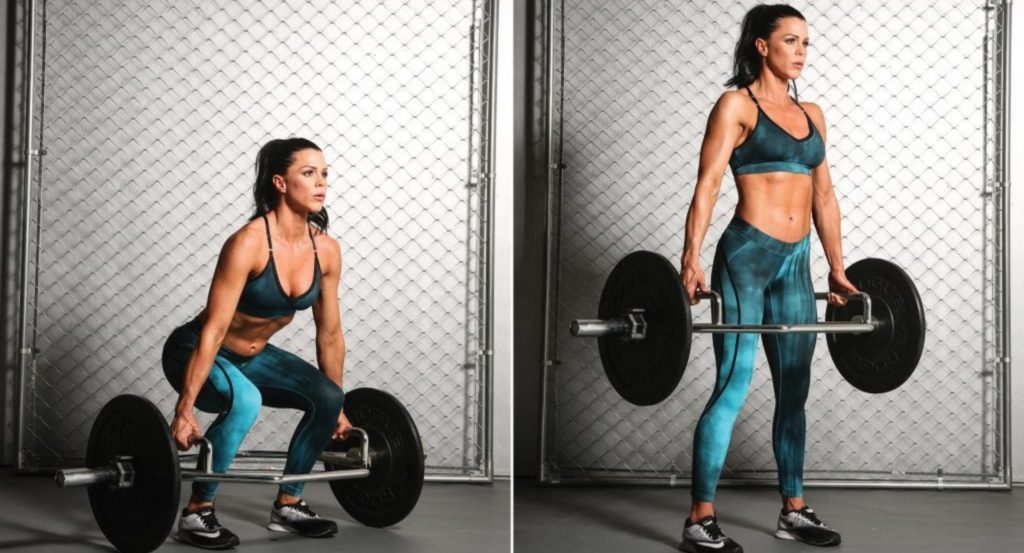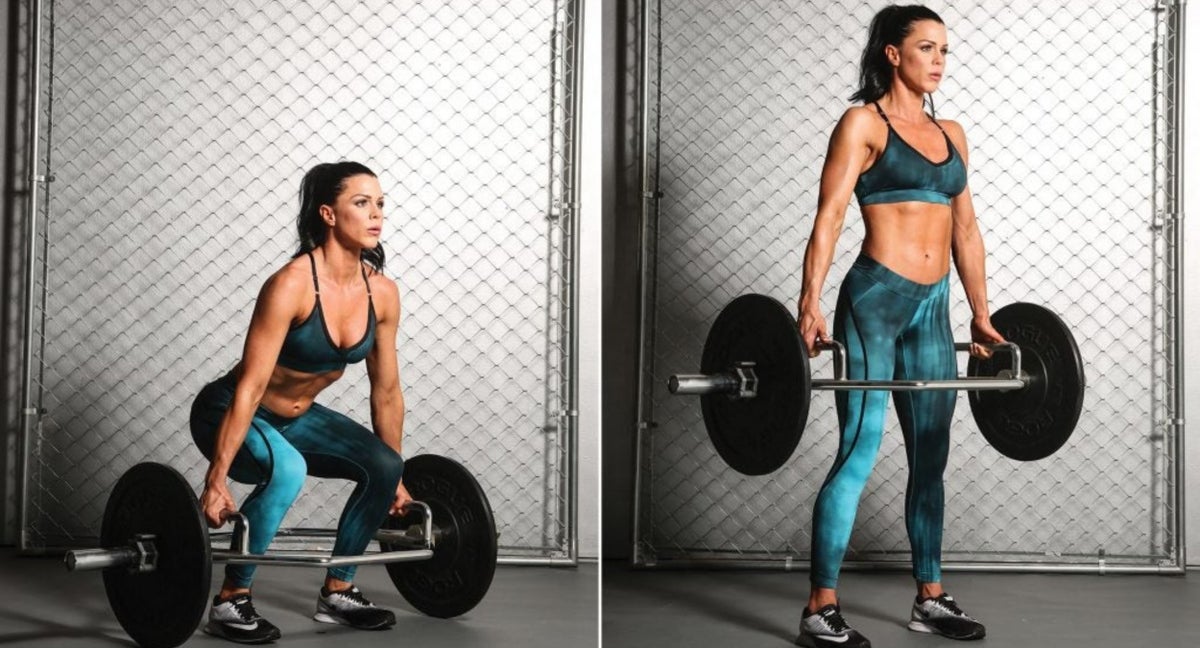

Get access to everything we publish when you
sign up for Outside+.
What’s a hex bar? It’s not a piece of gym equipment that has a witch’s curse on it, if that’s what you’re thinking. A hex bar — also known as a trap bar — is named for its hexagonal shape. It’s most often used for shrugs and during deadlifts to reduce the lumbar strain (slightly) compared to conventional barbell. Compared with the barbell deadlift, the hex bar keeps the weight closer to your center of gravity.
But if you’ve been staring at that hexagon-shaped bar at your gym and wondering what else to use it for, read up below on how best to use the hex bar to make total-body gains.
Here are five ways to strengthen your entire body with the hex bar, courtesy of personal trainer and USA Weightlifting Coach Denise Cervantes.
1. Deadlift
“The hex bar has versatile grips on it and allows you to stand in the middle of the bar, which helps you really target the posterior chain during a squat and deadlift as compared to a traditional barbell,” says Cervantes, who’s also a Sports Performance and Fitness Specialist at Herbalife. “Hex deadlifts can help athletes and sprinters increase their speed gains, while also helping all gym goers with everyday strength for tasks like groceries, laundry, mowing the lawn, and more.”
The move: Place the hex bar on the floor, loaded with the appropriate amount of weight plates for your strength level. Step into the center of the hex and bend down by hinging at your hip crease to grasp the grips. Ensure you have a small bend in your knees and a bigger bend at the hip at the start. To begin the drive upward, shift your glutes backward, brace your core and drive your feet into the floor. Keep your shoulders back with your spine in a neutral position throughout movement as you stand up to the point where your hips and shoulders are stacked directly atop of each other. Keeping your midsection tight and shoulders back, drop your hips down and push your glutes out behind you as you lower the bar to the start position.
Pro tip: “Advanced athletes can add an extra degree of difficulty by doing deadlift jumps with a lighter load — even just the bar,” says Cervantes. “Be sure to land softly on your toes, and engage your core and lats throughout to control the bar during jumps.”
2. Floor Chest Press
You can do elevated push-ups with a hex bar, simply by putting plates on each side and then grasping the handles with your feet on the floor. But for a more aggressive chest-and-shoulder-building move, the floor press is a great option.
The move: Lie on the floor holding a hex bar, elbows out and your upper arms flush on the floor; your hands should be even with your upper chest. Before you begin, make sure you “set” your shoulders down so they are in contact with the floor and lift your chin. Bracing your core throughout, push the hex bar toward the ceiling until your elbows are straight but not locked, then lower carefully back to the start.
Pro tip: “I recommend bending your knees and planting your feet on the floor, which helps keep pressure off of your lower back during the press,” Cervantes says. “Also, a great cue when pushing from the floor is to ‘drive the low back towards the floor’ — this helps brace your abs during heavy lifts.”
3. Farmer’s Carry
This straightforward exercise works numerous bodyparts, either as prime movers or in an ancillary function, but don’t let that simplicity fool you: It’s tough! For this, you’ll just need the hex and a clear straightaway to walk back and forth at least 10 yards in distance. (If your gym floor is hard to navigate, consider an open cardio room.)
The move: Holding the hex bar in both hands at waist level, arms straight, you’ll walk forward in heel-toe style, keeping your shoulders back, core braced and head up. Walk 10 yards per set, trying for 3-4 sets in total.
Pro tip: “To up the intensity level, you can try doing these with the hex bar held overhead, elbows locked out, as you walk instead of having your arms at your sides,” Cervantes says. “No matter which version you do, just make sure to engage the abdominals and lats, which stops the bar from swaying excessively as you walk.”
4. Burpee Jumps
Hex bars aren’t just good for heavy and hard weightlifting — they are a good cardio tool as well.
“Burpee jumps will give you a dose of cardio while also practicing your footwork,” Cervantes says. “This drill also strengthens the mind-muscle connection and improves your overall coordination.”
The move: Stand facing an unloaded hex bar on the outside of the hex. Do a standard burpee, then jump off both feet into the center of the hex bar, and then again to the other side of the bar. Turn around and face the bar, do another burpee, then jump back inside the bar and immediately again to the original side where you began. Do 10 jumps total per set, aiming for 3-4 sets total.
“Beginners and anyone just learning this move should use an unloaded hex bar, while more advanced athletes can put weights on each side, which makes the jumps in and out of the bar harder because the hex bar is elevated and the obstacle to jump is higher,” Cervantes suggests.
Pro tip: Not familiar with a burpee? To do one, you’ll stand upright with your feet shoulder-width apart. Start by squatting down as you put your hands out in front of you, then kicking your legs out behind you as your hands reach the floor.
From this position, you’ll lower yourself to the floor for a full push-up, then quickly press yourself back up with your arms while pulling your feet in underneath you again. Extend at the hips and knees to return to standing, continuing through with your hands overhead into a jump.
When you come back down, you’ll do the jump into the hex bar and then to the other side, where you’ll turn around and repeat the sequence.
5. Plank Hold
Traditional planks can get a little, well, boring — but a hex bar can spice them up by adding an element of instability, meaning you have to work harder to maintain your balance as you blast that core to the max.
The move: Get on the floor in push-up position, face down holding the handles of a hex bar with 25-pound or 45-pound plates on each side. Find your balance, tighten your core and squeeze the glutes as you hold the plank with arms straight. Do 3-4 sets of up to 1 minute each. “The hex bar will feel like it wants to be a teeter-totter,” Cervantes warns. “It’s your job to keep it as stable as possible.”
Pro tip: For beginners, it’s okay to perform a modified plank hold on your knees instead of having your knees elevated while you’re balanced on your toes. “Advanced athletes can try to perform roll-outs, like what you’d do with an ab rolling device,” Cervantes adds. “Assume the knee-down position and roll a loaded hex bar out and away from the body so that your torso and arms end up fully extended. Then you use your core to pull the bar back in under your chest.”
Published at Tue, 25 Jan 2022 12:00:47 -0800






